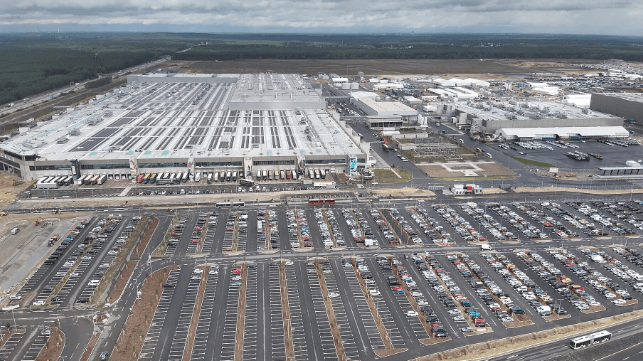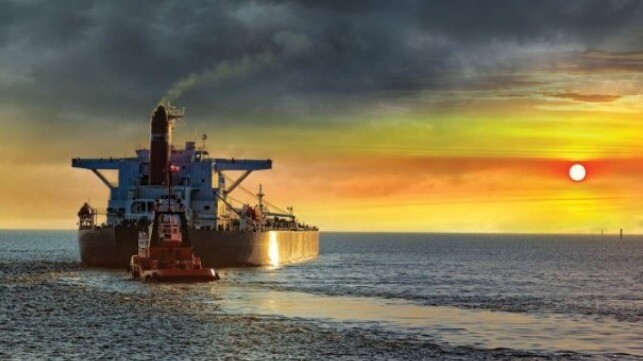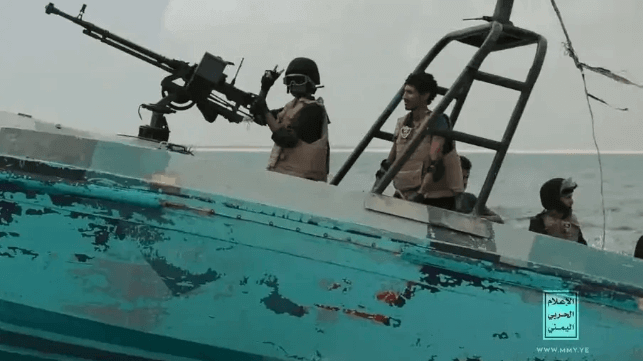Red Sea Crisis is Disrupting the Electric-Car Industry

[By Tom Stacey]
Automotive giants Tesla and Volvo have announced pauses to the production of their electric vehicles (EVs) in Europe. Electric vehicles are seeing record sales and demand worldwide, but a lack of parts means that factories cannot sustain their production.
The reasons for this are complex. Parts are taking longer to deliver as attacks by Houthi rebels force ships to avoid the Red Sea. And there are also issues around the monopoly that Chinese factories hold on many EV components, including crucial lithium batteries.
These factors have made it harder (and more expensive) to move parts across the globe to support EV production in Europe.
Modern global supply chains are tightly orchestrated. Moving goods to factories (and away from them to customers) is heavily demand-driven. Forecasting this demand has become a huge industry, valued at over US$27 billion.
But even with all this intelligence, political tensions, pandemics and even stuck ships can turn this industry on its head overnight. This is particularly the case where the supply side is constrained, as it is with EV batteries from China.
In 2021, a container ship called the Ever Given ran aground in the Suez Canal, blocking this vital shipping route from the Far East to Europe for the best part of a week. The blockage prevented goods from passing through the canal, so had the knock-on effect of raising container shipping prices.
Even though the Suez Canal has been open for two years, the recent attacks on commercial ships in the Red Sea have caused shipping companies to divert their ships to less direct routes – adding significant costs and time.
What does this mean for consumers and the planet? And are there ways for EV manufacturers to circumvent these risks?
Supply chains are fickle things
If manufacturers cannot produce due to shortages, then factories that make a single product such as Tesla’s gigafactory near Berlin (which produces the best-selling Model Y SUV) have one option – to idle the lines. Hourly-paid workers are sent home and where possible, salaried staff will continue in other roles such as safety checking and testing.
Tesla and Volvo have other factories and other product lines that can keep running. But even finished vehicles traveling from plants in China for sale in Europe are affected by the need to avoid the Red Sea. Vehicle manufacturer, Geely, which also produces Volvo vehicles in China, has warned of delays to European consumers expecting their new cars in early 2024.
Delays are not the only issue associated with shipping parts and vehicles around Africa to avoid the Red Sea. The 3,000 extra miles traveled by ships means they burn more fuel – a lot more fuel.
Peter Sand, a shipping analyst at ocean and air freight analytics platform, Xeneta, has estimated conservatively that each ship taking this route produces 2,700 extra tons of CO?. If the international shipping industry were a country, it would already be among the world’s top carbon-emitting nations. And greenhouse gas emissions from ships are projected to increase by up to 50% by 2050.
EVs are undoubtedly better for the environment than their combustion engine counterparts. However, when supply is constrained, buyers often have little choice but to delay making the switch. Sales figures from 2023 show that private buyers still did not purchase as many EVs in the historically buoyant month of September as they did in the year before due to uncertainty in the market.
Fleet demand remains strong. But the market can only grow as fast as manufacturers can make cars. And pausing production is not going to help the transition.
Can manufacturers square this circle?
Clearly, these pinch points in the global supply chain have huge repercussions for manufacturers and consumers. Tesla’s factory in Germany is tight-lipped about actual production figures, but reports claim it makes around 4,000 units per week. Each car makes around US$8,000 profit, so this shut down could, in raw terms, lead to a loss of US$64 million in profit.
How do they prevent this? Supply chains do have some element of elasticity, but supply chain managers are always keen to reduce the potential of something known as the “bullwhip effect”. This is where marked differences in order quantities lead to even more shortages down the line. Managing expectations and reassuring buyers will thus help to smooth any issues with supply.
Making supply chains more resilient is also a huge area of research. Rerouting ships to prevent lost components is an example of this concept being put into practice.
If the parts were lost to rebel forces or pirates by taking the Red Sea route, then the revenue loss would be even larger. So although diverting routes is worse for the planet and arguably bad press, it would seem to be the lesser of two evils.
Multinational automotive manufacturer Stellantis has announced that it is instead bypassing the Red Sea by air-freighting parts to its EU factories. But, while this is faster than shipping parts around Africa, it’s not good for either CO? emissions or cost.
Stellantis is relying on airfreight to cope with temporary supply disruptions. Summit Art Creations/Shutterstock
Keeping the global economy running
To reduce the disruptive potential of geopolitical tensions, Tesla and other automakers are attempting to produce their product closer to the consumer. The strategy is to put factories on each continent or geographical area where their products are sold.
However, as China still produces many of the core EV parts, manufacturers will have to invest heavily in their suppliers and put them closer to their factories.
Ultimately, this will require investment in skills and more factories. But with dropping profit margins, Chinese manufacturing dominance and inflationary pressures, it will continue to be a headache to implement.
Tom Stacey is a Senior Lecturer in Operations and Supply Chain Management at Anglia Ruskin University.
Top image: The Tesla Berlin-Brandenburg plant (Michael Wolf Penig / CC BY SA 3.0)
This article appears courtesy of The Conversation and may be found in its original form here.
EU's Replacement Strategy For Russian Oil Disrupted by Red Sea Attacks

Ttwo years after the invasion of Ukraine prompted a big shakeup in Europe's energy supplies, the evolving security situation in the Red Sea is reshaping trade flows once again.
According to tanker trade tracker Kepler, multiple EU-bound tankers are rerouting around the southern tip of Africa in order to avoid the risk of Houthi attacks off Yemen.
“European countries are seen as complicit in the Israel-Hamas war. They would rather go around the Cape of Good Hope versus taking a chance through the Red Sea," he told CNBC.
Since tankers move slowly, this increases the delivery timetable for oil flows from the Middle East to Europe by a matter of weeks, and increases the time required for the return journey by just as much. This reduces tanker availability, increases delivery cost, and makes other suppliers in the Atlantic basin more competitive (for some commodities).
European customers are turning to American and Brazilian refiners to source diesel more often, according to CNBC, and reducing dependence on longtime suppliers located east of Suez.
The disruption is a new wrinkle for commodity traders and refiners serving the EU market. Until 2022, Europe sourced 20 percent of its oil from Russia, along with much of its imported diesel. EU governments decided to phase out those supplies after the invasion of Ukraine, sending a signal of opposition and forcing Russian producers to find new markets. To substitute those lost Russian barrels, Europe turned to other suppliers in the Mideast and (for refined products) India. With access to the Red Sea now less certain, these suppliers are less accessible and affordable, forcing another adjustment in EU sourcing.
China and Russia Get a Free Pass Through Houthis' Red Sea Blockade

The elevated security risk in the Red Sea has been bad news for almost every shipowner, but some parties may end up benefiting - or at minimum, may be able to continue their business as usual.
American and Israeli shipping interests are at risk of attack, but Houthi leaders have explicitly said that Russian and Chinese vessels will be guaranteed safe passage. “Our goal is to raise the economic costs for [Israel],” Houthi spokesman Muhammad al-Buheiti told Izvestia last week. “As for all other countries, including Russia and China, their shipping in the region is not threatened."
Chinese shipping interests appear to be aware of this exception. Many China-linked ships have been broadcasting "All Chinese" or "Chinese Ship" as their AIS "destination" during transits through the Red Sea. Likewise, some ships with Russian cargoes have been broadcasting some variant of "Vessel No Contact Israel."
The proportion of Chinese shipping in Red Sea container traffic has been rising dramatically, according to Lloyd's List, though total container traffic has plummeted). One brand new Chinese carrier even appears to specialize in Red Sea transits. Recently-launched Sea Legend Shipping operates a fleet of seven Panamax boxships that run between China and Turkey, calling at ports in the Gulf of Aden and the Red Sea on the way out and back. It even calls periodically in Yemen (Aden) and serves the Houthi-controlled port of Hodeidah through a transshipment connection. (Lloyd's List first identified Sea Legend's niche service.)
Sea Legend has benefited from naval escort protection from China's PLA Navy, the company says - a relatively rare advantage. The PLA Navy has been conspicuously absent from the allied policing operation off Yemen, though it has warships in the area and a large base in nearby Djibouti. Sea Legend's site highlights that in "the style of a great country, flying the five-star red flag, the Chinese navy escorts" its vessels. It also lists the scheduled transit times for PLA-protected convoys.
The Red Sea-Suez route is by far the fastest option for ocean freight between the Far East and the Mediterranean. The alternative is a trip around the southern tip of Africa, which adds about 10 days onto a typical container ship voyage, raising cost and imposing delays on customers. Vessels that can continue to use the Suez Canal may have a competitive advantage relative to their peers.
The comparative safety for Russian and Chinese vessels may have political roots. Russia's government has railed against the UK-U.S. security operation in the Red Sea and against the Israeli operation in Gaza; both of these positions align with the Houthis' demands. The Russian Foreign Ministry has called the anti-Houthi naval mission "a violation of Article 2 of the UN Charter" and a risk to regional stability.
For its part, China has called for a ceasefire in Gaza and an Israeli-Palestinian peace conference, aligning with Houthi demands. It also has a close relationship with the Houthis' Iranian sponsors, according to the White House. “China has influence over Tehran, and they have the ability to have conversations with Iranian leaders [about the Houthis] that we can’t," National Security Council spokesman John Kirby told Politico on Tuesday.
No comments:
Post a Comment